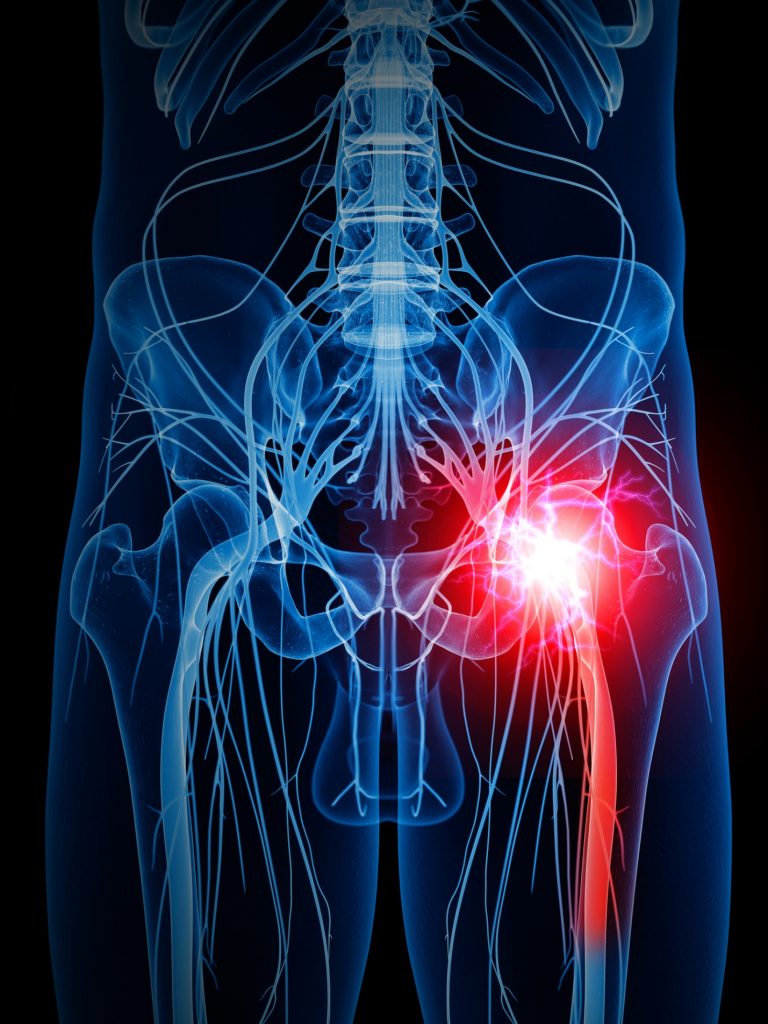Sciatica

You may be a candidate for Endoscopic Discectomy
Sciatica
- Lower back pain
- Pain in the rear or leg that intensifies when standing or sitting
- Hip pain
- Weakness, numbness or difficulty moving the leg or foot
- A constant pain on one side of the rear
- Sensations that make it difficult to stand from a sitting position
- A “pins-and-needles” feeling
Sciatica Causes
The underlying causes can be as various as its symptoms. However, some of the most common instigators are:
As discs in the spine age, they begin to show wear and tear. This process can be accelerated by other factors and may cause sciatica as your spinal makeup begins to change.
Also known as a “slipped” or ruptured disc, a herniation occurs when a tear in the disc’s hard outer layer, known as the annulus, allows the inner liquid-like nucleus to leak into the spinal canal. Pressure results and, if located near the sciatic nerve, can lead to sciatica. Herniated discs usually happen because of strenuous labor or everyday tasks that are physically straining.
Sciatica may be caused by spinal stenosis, or the narrowing of the spinal canal. When spinal stenosis occurs, tension is placed on the spinal cord and may irritate and strain local nerves.
- Piriformis Syndrome
The slim piriformis muscle is located in the buttocks, near the hip joint, and helps people move their thighs, maintain balance and walk. The sciatic nerve travels closely to this muscle and can easily become pressed or irritated when the piriformis spasms or contracts. Runners and other athletes are especially susceptible to this type of trigger.
Occasionally, a vertebra in the spine can slip forward and slide over the bone beneath it. This condition is known as spondylolisthesis and is most common in the lower back, where straining nearby nerves can cause sciatica.
- Sudden injury or accident
Some unexpected traumatic events, such as a car accident, can lead to sciatica. Injuries sustained and new scar tissue can place stress on the sciatic nerve.
- Pregnancy
During pregnancy, pain in the back of the thighs spurred by shifts in the pelvic region can be misdiagnosed as sciatica. However, there are situations in which the sciatic nerve is actually being pressed as a result of these changes. Speak to your doctor if you think you are suffering from sciatica or pelvic groin pain.
- Infection
Rarely, an infection in the spine may cause sciatica.
- Other health issues, such as tumors
Growths and related health issues may irritate the sciatic nerve and lead to chronic sciatica.
Sciatica Symptoms
Symptoms often include:
- Mild tingling sensations throughout the leg, calf or foot
- Dull, aching pain throughout the leg, calf or foot
- Burning sensations, known as lumbar radiculopathy
- Sharp pain in parts in the leg or hip
- Weakness and numbness in the affected leg
Sciatica Non-Surgical Treatment Options
- Physical therapy and massage therapy
- Anti-inflammatory medications
- Lifestyle changes
- Epidural steroid injections
Sciatica Surgical Treatment Options
If conservative treatments do not ease your sciatica-related pains, you may consider undergoing minimally invasive surgery. Minimally invasive procedures focus on removing the condition instead of only treating the symptoms. These approaches also prioritize extremely small incisions and shortened recovery times.
Common minimally invasive surgeries are:
- Epidural steroid injections
An Endoscopic microdiscectomy involves trimming and removing fragments of intervertebral discs that have broken away and are pressing on the sciatic nerve or spinal cord.
- Endoscopic Decompression
Sometimes, a portion of the arthritic vertebral bone and thickening of the ligament inside the spinal canal will be trimmed or removed to curtail sciatica.
When compared with traditional open operations, our Microspine & Minimally Invasive technique yield:
- Shortened recovery times that allow patients to return to work, school and other daily activities faster
- Less post-operative pain
- A reduced risk of scarring and blood loss
- Minor trauma to surrounding tissues, leaving the majority of muscle unaffected
- Fewer potential complications
We look forward to helping you feel better, faster! CONTACT US
REQUEST APPOINTMENT
If you are suffering from low-back pain, neck pain, herniated disc, sciatica, pinched nerve and have been researching minimally invasive spine surgery as well as laser spine surgery, schedule an appointment to speak to Dr. T and Microspine Team today.
Microspine
Office
14300 N Northsight Blvd, #213. Scottsdale, AZ 85260
Phone: 602-833-2141
Fax: 602-610-3878
Office hours M-F: 8 AM to 5 PM
By appointment only
Dr. T serves the areas of Anthem, Apache Junction, Avondale, Buckeye, CasaGrande, Cave Creek, Chandler, Flagstaff, Fountain Hills, Gilbert, Glendale, Goodyear, Laveen, Maricopa, Mesa, Paradise Valley, Payson, Peoria, Phoenix, Prescott, Prescott Valley, Queen Creek, Safford, SanTan, Scottsdale, Sedona, Showlow, Suncity, Suncity West, Tempe, Tucson, Yuma, and surrounding areas.
